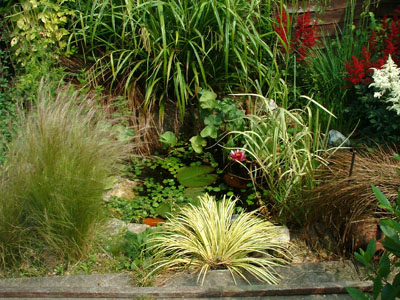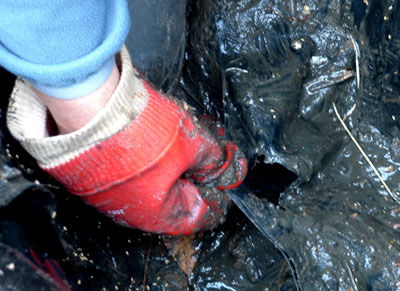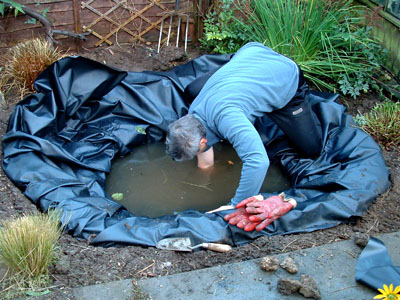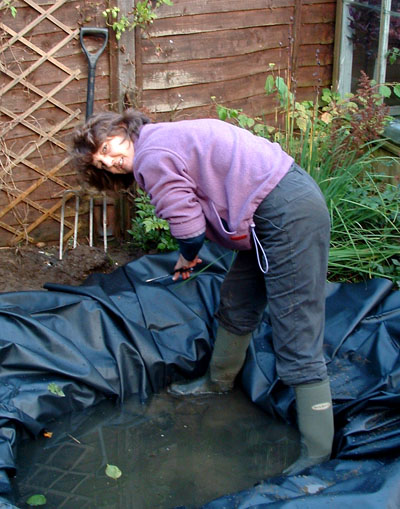September 29th 2005 - Oh no, the pond's leaking!
The pleasing combination of Rudbeckia fulgida var. sullivantii 'Goldsturm' and Stipa tenuissima that I mentioned last time is no more. Disaster struck - a leaking pond, meaning that we had to cut back the plants to get at the pond, empty it and replace the liner. The Stipa is now a bristly lump till next year. Actually, most of the plants are now bristly lumps till next year.
"...the water went down by about three quarters; we sighed and resigned ourselves to the wet and messy job of fixing it..."
The weather had been warm and breezy and, to begin with, we thought that it was evaporating off, but after several days of checking we realised that it really was leaking. Left for three days to be certain, the water went down by about three quarters; we sighed and resigned ourselves to the wet and messy job of fixing it.

How the pond looked earlier this year
With the days cooling and autumn just around the corner we knew we’d have to work quickly to be in time for the frogs to hibernate. If you’re going to have a pond leak to mend, this is probably the best time of year for it, so in many ways we were lucky. By now, the plants are pretty much past their best, the water insects have hatched and left the pond, most of the tadpoles are now frogs (though there are still some tadpoles swimming about) and the frogs are almost, but not quite, ready to tuck themselves into muddy corners and sleep through the cold weather. It also meant we could change the edge planting and re-think the water plants.
It was the perfect opportunity to get rid of the Carex pendula that I had put in. It’s the usual story - and we’ve all done it, so don’t you go feeling superior - I’d seen it at a nursery, bought two and planted them by the pond. The first year they were charming, with arching evergreen leaves and long stems of seed heads that hung over the water. By the second year, they had doubled in size and I was finding seedlings all over the garden. By the third year they had transformed into monsters and clearly had to go.
"Weeding some of it out last year, I found that it had formed a mass of roots about six inches thick on each ledge in the pond"
Another plant to be consigned to the compost heap was what I now know to be Floating pennywort (Hydrocotyle ranunculoides), given to me by someone who will remain nameless. Initially, it too looked lovely. It was a pleasant shade of green and the floating leaves provided shade to the water creatures. Then more shade, and more. Weeding some of it out last year, I found that it had formed a mass of roots three inches thick on each ledge in the pond. Reading up on it, I discovered that it’s horribly invasive and is choking the waterways of the UK.
There’s more. Being cheap and, in those days rather gullible, I’d bought a selection of pond plants ‘specially for a small pond’ from a supermarket. There was a lovely pink water lily - Nymphaea something. In it went. It was fine to start with, its waxy pink flowers looking very impressive, but by the third year each leaf must have been 30cm across. Bear in mind that our pond has the area of a decent sized dining table and you see the predicament.
Apart from the inappropriate plants that I had introduced, blanket weed was spreading. Duckweed also made its first appearance this summer, so we had the chance to reduce both populations considerably before they got going.
The process itself was actually pretty quick and straightforward. We measured the pond and Karl went out for a new liner whilst I set about cutting back the edging plants. Once those were out of the way, we set out a line of plastic storage tubs and started pulling out the plants and dropping them into the tubs.
"You don’t realise how many you’ve accumulated till they have to be moved.."
Next came all the rocks and stones. You don’t realise how many you’ve accumulated till they have to be moved and it occurred to me that there have been many, many times when I’ve dug up a nice looking stone or fossilised shell and said ‘That would look okay as part of the pond edging’. There were piles of the stuff.
After that, we used a bucket to remove the water and the pond creatures, dividing it between the tubs and filling them to the brim. The idea was that if we didn’t get finished in one day, they’d be okay in the tubs of water, with the plants for company.
At the bottom of the pond was a layer of muddy sludge. Two sleepy frogs were tucked into folds of the lining and were regretfully evicted and added to one of the tubs. A couple more had jumped out and hidden amongst a corner of plants and logs that we decided to leave undisturbed. For the tubs that held frogs, we made ‘in’ and ‘out’ ramps so they could get out and find something to eat in the night.
Under the bottom mud we found the hole, quite a big one too, where the roots of some vigorous plant had pierced the liner. I suspect it was that water lily, so it’s a good thing that I’d decided it was a thug anyway, because it isn’t going back in, that’s for sure.

The hole in the lining
We turned to the new liner – and then looked at the old one, still in position. The day was getting on and we decided to take the lazy way out and put the new one on top of the old, having shovelled in some sand to line the bottom (we may regret this idleness in a couple of years, but we’ll see what happens). As the weather was quite warm the liner was still flexible, not like when we first put the pond in a few Februaries ago, when it was as stiff as cardboard.
"...fill a bit, shift the liner, trim a bit, fill a bit more"
Liner in place, we began the process of fill a bit, shift the liner, trim a bit, fill a bit more until the light faded. The only mishap came when the fell scissors into the water and had to be fished out. Leaving the water creatures in the tubs for the night, we put away the tools and went in to wash off the mud.

Karl looks for the scissors
The next day we made short work of replacing the edging stones and reinstating the beach area. Next came the rather painstaking business of separating the assorted creatures from the plants the putting them back in the water. The mud remaining in the tubs was carefully tipped towards the middle of the pond so it would form a good layer on the bottom. The water plants we decided to keep - Marsh marigolds (Caltha palustris), some small reeds, a variegated Acorus, Pontederia Cordata (Pickerel weed) were reduced in size before being repotted and put into their new positions.
Most of the plants went on to the second shelf down and with the water still being clouded with silt, it was impossible to tell exactly where it was. I groped about to find the right spot for each plant and, as I did so, I discovered that this second ledge was where the adult frogs were resting. Several times, as I reached into the water to feel for a hard surface, my questing fingers found a frog instead. The poor things must have become quite impatient by the time I’d finished.
The final comment is that the Muck Boots worked really well in the water and we didn't get cold or wet feet. This was their first test as far as this much wetness goes and I have to say they did the job very well indeed.

In the pond
© Copyright Miranda Hodgson 2005